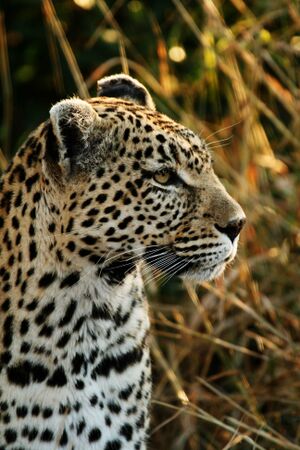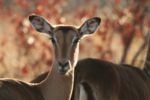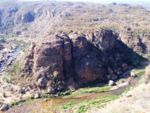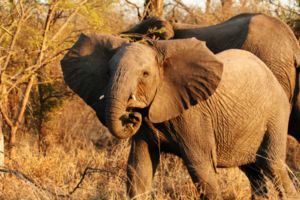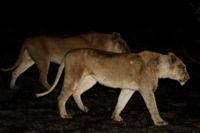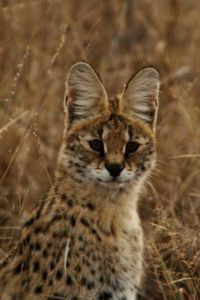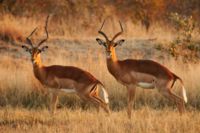Kruger National Park: Difference between revisions
imported>Lee R. Berger |
mNo edit summary |
||
| (7 intermediate revisions by 5 users not shown) | |||
| Line 1: | Line 1: | ||
{{ | {{subpages}} | ||
'''The Kruger National Park''', [[South Africa|South Africa]] is located in the lowveld and situated between the vast [[Mozambique]] coastal plains and the towering [[Drakensberg mountains|Drakensberg mountain range]]. | '''The Kruger National Park''', [[South Africa|South Africa]] is located in the lowveld and situated between the vast [[Mozambique]] coastal plains and the towering [[Drakensberg mountains|Drakensberg mountain range]]. | ||
{{Image|Leopard face small.jpg|right|300px|A female leopard, Kruger park. }} | |||
| Line 11: | Line 11: | ||
==Vegetation== | ==Vegetation== | ||
There are approximately 2000 plant species found in seven basic vegetation eco-systems in the Kruger Park, although within each of these plant diversity and abundance can vary greatly.From the Pafuri gate in the far Northern [[Makuleke]] region to the Malelane gate in the far south is over 440 km<ref name="Kruger"/>. Plant diversity and species prevalence is generally driven by rainfall and underlying geology. There have been at least 30 different types of [[Botany|botanical]] communities recognized in the park<ref name="Kruger"/>. | There are approximately 2000 plant species found in seven basic vegetation eco-systems in the Kruger Park, although within each of these plant diversity and abundance can vary greatly.From the Pafuri gate in the far Northern [[Makuleke]] region to the Malelane gate in the far south is over 440 km<ref name="Kruger"/>. Plant diversity and species prevalence is generally driven by rainfall and underlying geology. There have been at least 30 different types of [[Botany|botanical]] communities recognized in the park<ref name="Kruger"/>.{{Image|Impala ewe.jpg|left|150px|An Impala ewe in the Kruger. }} | ||
===Major ecosystems=== | ===Major ecosystems=== | ||
{{Image|Northern kruger.jpg|right|150px|Northern Kruger park near Lanner Gorge. }} | |||
*Mopaneveld – a mix of Mopane trees found on granites and basalts. | *Mopaneveld – a mix of Mopane trees found on granites and basalts. | ||
*Sandveld – no single species of plant dominates. The geology is dominated by [[Sandstone|sandstone]] koppies (hills). | *Sandveld – no single species of plant dominates. The geology is dominated by [[Sandstone|sandstone]] koppies (hills). | ||
| Line 25: | Line 25: | ||
==History== | ==History== | ||
===Ancient history=== | ===Ancient history=== | ||
The Kruger National Park contains remains of [[Dinosaur|dinosaurs]] dating back to [[Triassic]] and the sandstones of the far North record the presence of great deserts of the [[Jurassic]] that dominated the region almost 200 million years ago<ref name="Berger">{{cite web|url=http://www.profleeberger.com/files/A_History_of_the_Makuleke_licensed_copy.pdf|title=the History of the Makuleke Concession|accessdate=|author=Berger, L.R.|authorlink= |coauthors= |date=2005 |format= |work= |publisher=Wilderness Safaris|pages= |language= |archiveurl= |archivedate= |quote= }}</ref>. [[Archeology|Archeologically]] throughout the park there is evidence of early [[Hominin|hominin]] occupation including handaxes dating back to around 1.5 million years ago, tools of the [[Middle stone age|Middle]] and [[Late stone age|Late stone age]] as well [[Rock art|rock art]] <ref name="Berger"/>. | The Kruger National Park contains remains of [[Dinosaur|dinosaurs]] dating back to [[Triassic]] and the sandstones of the far North record the presence of great deserts of the [[Jurassic]] that dominated the region almost 200 million years ago<ref name="Berger">{{cite web|url=http://www.profleeberger.com/files/A_History_of_the_Makuleke_licensed_copy.pdf|title=the History of the Makuleke Concession|accessdate=|author=Berger, L.R.|authorlink= |coauthors= |date=2005 |format= |work= |publisher=Wilderness Safaris|pages= |language= |archiveurl= |archivedate= |quote= }}</ref>. [[Archeology|Archeologically]] throughout the park there is evidence of early [[Hominin|hominin]] occupation including handaxes dating back to around 1.5 million years ago, tools of the [[Middle stone age|Middle]] and [[Late stone age|Late stone age]] as well [[Rock art|rock art]] <ref name="Berger"/>.{{Image|Young bull elephant.jpg|right|300px|Young bull elephant mock charging in the Kruger park. }} | ||
====Thulamela==== | ====Thulamela==== | ||
One of the archeological highlights of the Kruger park is the stone-walled city of [[Thulamela]] in the far North. Thulamela was the political capital of an Iron age kingdom that thrived in the region between 1200 and 1640 AD<ref name="Berger"/>. | One of the archeological highlights of the Kruger park is the stone-walled city of [[Thulamela]] in the far North. Thulamela was the political capital of an Iron age kingdom that thrived in the region between 1200 and 1640 AD<ref name="Berger"/>. | ||
==Modern history== | ==Modern history== | ||
By the mid-1800’s wildlife in the area that would become Kruger had been decimated by over-hunting in an un-regulated environment<ref name="Kruger"/>. [[Rinderpest]] in 1896 further decimated wildlife. Then president of the Transvaal Boer Republic, Paul Kruger, proclaimed the 4,600 hectare Sabie Game Reserve in 1898 and then the Shingwedzi Reserve which stretched between the Shingwedzi and Luvuvhu Rivers<ref name="Kruger"/>. | By the mid-1800’s wildlife in the area that would become Kruger had been decimated by over-hunting in an un-regulated environment<ref name="Kruger"/>. [[Rinderpest]] in 1896 further decimated wildlife. Then president of the Transvaal Boer Republic, Paul Kruger, proclaimed the 4,600 hectare Sabie Game Reserve in 1898 and then the Shingwedzi Reserve which stretched between the Shingwedzi and Luvuvhu Rivers<ref name="Kruger"/>.{{Image|African elephant sabi.jpg|left|200px|Bull elephant in the Kruger park. }} | ||
In 1902 [[James Stevenson-Hamilton]] was appointed as head ranger of both reserves and quickly earned the nickname “Skukuza”(He who sweeps clean) for his vigorous anti-poaching and anti-farming methods and the forced removal of people living in the reserves<ref name="Kruger"/>.<ref name="Kruger history">{{cite web |url=http://www.krugerparkreservations.com/History.asp|title=Kruger History|accessdate=2007-08-04|author=Kruger National Park|authorlink= |coauthors= |date=2007 |format= |work= |publisher=|pages= |language= |archiveurl= |archivedate= |quote= }}</ref>. | In 1902 [[James Stevenson-Hamilton]] was appointed as head ranger of both reserves and quickly earned the nickname “Skukuza”(He who sweeps clean) for his vigorous anti-poaching and anti-farming methods and the forced removal of people living in the reserves<ref name="Kruger"/>.<ref name="Kruger history">{{cite web |url=http://www.krugerparkreservations.com/History.asp|title=Kruger History|accessdate=2007-08-04|author=Kruger National Park|authorlink= |coauthors= |date=2007 |format= |work= |publisher=|pages= |language= |archiveurl= |archivedate= |quote= }}</ref>. | ||
The reserves were merged in 1926 by the purchase of the seventy farms lying between them and the Kruger National Park was proclaimed. The park was opened to tourism in 1927<ref name="Kruger"/><ref name="Kruger history"/>. | The reserves were merged in 1926 by the purchase of the seventy farms lying between them and the Kruger National Park was proclaimed. The park was opened to tourism in 1927<ref name="Kruger"/><ref name="Kruger history"/>. | ||
| Line 40: | Line 40: | ||
===Large mammals=== | ===Large mammals=== | ||
====Carnivores==== | ====Carnivores==== | ||
*Lion | *Lion{{Image|Lions at night.jpg|right|200px|Lionesses hunting at night in the Kruger park. }} | ||
*Leopard | *Leopard | ||
*Cheeta | *Cheeta{{Image|Serval portrait.jpg|right|200px|A serval in the Kruger Park. }} | ||
*Caracal | *Caracal | ||
*Serval | *Serval | ||
| Line 51: | Line 51: | ||
====Other large mammals==== | ====Other large mammals==== | ||
There are many species of larger mammals in the Kruger park that form the basis of the mammalian ecosystem. In particular the larger browsing and grazing animals effect the distribution and density of the plant community <ref name="kruger animals">{{cite web |url=http://www.saparks.com/resources/index-animals.htm|title=SANP|accessdate=2007-08-18||author=SANP|authorlink= |coauthors= |date=2004 |format= |work= |publisher=|pages= |language= |archiveurl= |archivedate= |quote= }}</ref>. The following is a list of selected non-carnivore larger mammals<ref name="kruger animals"/><ref name="Kruger"/>. | There are many species of larger mammals in the Kruger park that form the basis of the mammalian ecosystem. In particular the larger browsing and grazing animals effect the distribution and density of the plant community <ref name="kruger animals">{{cite web |url=http://www.saparks.com/resources/index-animals.htm|title=SANP|accessdate=2007-08-18||author=SANP|authorlink= |coauthors= |date=2004 |format= |work= |publisher=|pages= |language= |archiveurl= |archivedate= |quote= }}</ref>. The following is a list of selected non-carnivore larger mammals<ref name="kruger animals"/><ref name="Kruger"/>.{{Image|Bushbuck.jpg|right|200px|Male bushbuck in the Kruger park. }} | ||
*Elephant | *Elephant | ||
*Baboon | *Baboon | ||
| Line 76: | Line 76: | ||
*Tsessebe | *Tsessebe | ||
*Lichtenstein’s hartebeest | *Lichtenstein’s hartebeest | ||
{{Image|Red billed oxpecker.jpg|left|200px|Red-billed oxpecker, Kruger park. }} | |||
===Birds=== | ===Birds=== | ||
| Line 82: | Line 82: | ||
===Reptiles=== | ===Reptiles=== | ||
There are 54 [[Snake|snake]] species found in the Kruger, 9 of which are highly venomous to humans. [[Crocodiles]] are found in all eight major rivers<ref name="Kruger"/>. | There are 54 [[Snake (animal)|snake]] species found in the Kruger, 9 of which are highly venomous to humans. [[Crocodiles]] are found in all eight major rivers<ref name="Kruger"/>. | ||
===Insects=== | ===Insects=== | ||
Parts of Kruger, particularly the far north are considered moderate to high risk malaria areas. Malaria is at its peak during the rainy season roughly between October and May. | Parts of Kruger, particularly the far north are considered moderate to high risk malaria areas. Malaria is at its peak during the rainy season roughly between October and May.{{Image|Vervet monkey.jpg|right|200px|A vervet monkey in the Kruger park. }}{{Image|Dwarf mongoose.jpg|right|200px|Dwarf mongoose in the Kruger park. }} {{Image|Impala rams.jpg|right|200px|Impala rams in the Kruger park. }} | ||
==Camps== | ==Camps== | ||
| Line 122: | Line 122: | ||
==References== | ==References== | ||
{{reflist}} | {{reflist}}[[Category:Suggestion Bot Tag]] | ||
[[Category: | |||
Latest revision as of 06:00, 9 September 2024
The Kruger National Park, South Africa is located in the lowveld and situated between the vast Mozambique coastal plains and the towering Drakensberg mountain range.
Geography and Climate
The Kruger Park consists of approximately 20,000 square kilometers which is an area larger than either Wales or Israel [1]. Park habitats range from high rainfall mountain to semi-arid plains. Summers in the Kruger are hot with erratic rainfall. Winters are generally temperate and dry. Average rainfall is approximately 500 mm per annum[1]
Vegetation
There are approximately 2000 plant species found in seven basic vegetation eco-systems in the Kruger Park, although within each of these plant diversity and abundance can vary greatly.From the Pafuri gate in the far Northern Makuleke region to the Malelane gate in the far south is over 440 km[1]. Plant diversity and species prevalence is generally driven by rainfall and underlying geology. There have been at least 30 different types of botanical communities recognized in the park[1].
Major ecosystems
- Mopaneveld – a mix of Mopane trees found on granites and basalts.
- Sandveld – no single species of plant dominates. The geology is dominated by sandstone koppies (hills).
- Sweetveld Plains – grassy plains located mostly on basalts, gneiss and granites.
- Mixed woodland – gentle rolling hills or flatlands dominated by woodlands and some grasslands. The underlying geology is granite or gneiss.
- Southwestern woodlands – densely wooded pockets and large granite outcrops.
- Lebombo – dry, rocky ridges situated on rhyolite.
- Riverine forest – densely wooded area along river banks.
History
Ancient history
The Kruger National Park contains remains of dinosaurs dating back to Triassic and the sandstones of the far North record the presence of great deserts of the Jurassic that dominated the region almost 200 million years ago[2]. Archeologically throughout the park there is evidence of early hominin occupation including handaxes dating back to around 1.5 million years ago, tools of the Middle and Late stone age as well rock art [2].
Thulamela
One of the archeological highlights of the Kruger park is the stone-walled city of Thulamela in the far North. Thulamela was the political capital of an Iron age kingdom that thrived in the region between 1200 and 1640 AD[2].
Modern history
By the mid-1800’s wildlife in the area that would become Kruger had been decimated by over-hunting in an un-regulated environment[1]. Rinderpest in 1896 further decimated wildlife. Then president of the Transvaal Boer Republic, Paul Kruger, proclaimed the 4,600 hectare Sabie Game Reserve in 1898 and then the Shingwedzi Reserve which stretched between the Shingwedzi and Luvuvhu Rivers[1].
In 1902 James Stevenson-Hamilton was appointed as head ranger of both reserves and quickly earned the nickname “Skukuza”(He who sweeps clean) for his vigorous anti-poaching and anti-farming methods and the forced removal of people living in the reserves[1].[3]. The reserves were merged in 1926 by the purchase of the seventy farms lying between them and the Kruger National Park was proclaimed. The park was opened to tourism in 1927[1][3]. By 1969 the park had been fenced by approximately 18,000 kilometers of wire fencing[1]. In 2002 kruger park was incorporated into the Greater Limpopo Transfrontier Park when an agreement was signed between South Africa, Zimbabwe and Mozambique to merge conservation areas in their respective countries. Once this process is completed the Transfrontier park will be the largest game reserve in the World[3].
Animals
Mammals
Large mammals
Carnivores
- Lion
- Leopard
- Cheeta
- Caracal
- Serval
- Spotted hyaena
- Brown hyaena
- Wild dog
- Black-backed jackal
Other large mammals
There are many species of larger mammals in the Kruger park that form the basis of the mammalian ecosystem. In particular the larger browsing and grazing animals effect the distribution and density of the plant community [4]. The following is a list of selected non-carnivore larger mammals[4][1].
- Elephant
- Baboon
- Impala
- Giraffe
- Pangolin
- Buffalo
- Kudu
- Zebra
- Waterbuck
- Wildebeest
- White rhino
- Black rhino
- Hippo
- Klipspringer
- Duiker
- Steenbok
- Eland
- Nyala
- Warthog
- Sable antelope
- Roan antelope
- Bushbuck
- Tsessebe
- Lichtenstein’s hartebeest
Birds
There are more than 520 recorded species of bird recorded in the Kruger Park of which approximately 380 are resident in the park year round[1].
Reptiles
There are 54 snake species found in the Kruger, 9 of which are highly venomous to humans. Crocodiles are found in all eight major rivers[1].
Insects
Parts of Kruger, particularly the far north are considered moderate to high risk malaria areas. Malaria is at its peak during the rainy season roughly between October and May.
Camps
- Balule
- Bateleur
- Berg-en-Dal
- Biyamiti
- Boulders
- Crocodile Bridge
- Hamilton’s Tented Camp
- Hoya Hoya
- Imbali Main Camp
- Jackalsbessie
- Jock of the Bushveld
- Letaba
- Lower Sabie
- Lukimbi Safari Lodge
- Malelane
- Maroela
- Mopani
- Mpananamana Main Lodge
- Mutlumvi Main Lodge
- Olifants
- Orpen
- Pafuri-Makuleke
- Pretoriuskop
- Punda Maria
- Roodewal
- Satara
- Singita Lebombo
- Sirheni
- Shimuwini
- Shingwedzi
- Skukuza
- Talamati
References
- ↑ 1.00 1.01 1.02 1.03 1.04 1.05 1.06 1.07 1.08 1.09 1.10 1.11 Hilton-Barber, B. and Berger, L.R. (2004). Exploring Kruger. Prime Origins Publishing. ISBN 0-620-31866-x.
- ↑ 2.0 2.1 2.2 Berger, L.R. (2005). the History of the Makuleke Concession. Wilderness Safaris.
- ↑ 3.0 3.1 3.2 Kruger National Park (2007). Kruger History. Retrieved on 2007-08-04.
- ↑ 4.0 4.1 SANP (2004). SANP. Retrieved on 2007-08-18.
